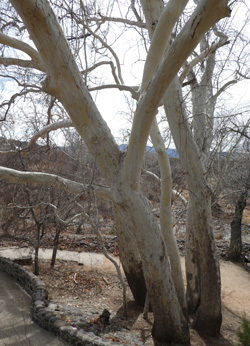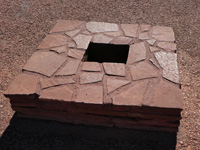Back From Arizona
March 16th, 2018Getting there:
Ron loves to travel. I’m less enamored with it. I like visiting places, but the hassles of planning, packing, and getting there would likely keep me at home if I didn’t have Ron to encourage me and to do most of our trip planning.
This past week we visited Arizona, with the Grand Canyon as our primary destination. If you’ve been reading this blog for a while, you know that we are into hiking. Our primary goal was to do a rigorous hike down the Grand Canyon’s Bright Angel Trail.
 The first step, of course, was getting there. We flew into Phoenix and took a couple of days to drive north, stopping at six National Monuments on the way. These monuments exist to preserve relics of First Nation pueblo life, but I admit the three things that excited me most were three natural features.
The first step, of course, was getting there. We flew into Phoenix and took a couple of days to drive north, stopping at six National Monuments on the way. These monuments exist to preserve relics of First Nation pueblo life, but I admit the three things that excited me most were three natural features.
The first was at Montezuma’s Castle. The cliff dwellings are amazing. It’s impossible not to consider the challenges they embody, the difficulties of getting to them, of hauling water and other necessities up a series of ladders, day after day. Still, what I fell in love with at this site was the grove of Arizona Sycamore trees — huge, and gorgeous in their white-bark. We were there so early in spring that they were not in leaf yet, but they were still very beautiful.
 The second feature I gushed over — pun intended — was the entirety of Montezuma’s Well. Here there is the well itself, which is a deep pool surrounded by cliffs. Water from a limestone cavern gushes into the bottom of the pool at a furious rate, causing sand to swirl, meters deep, above a bottom that no one has ever accurately measured. Despite this, the pool’s surface is calm and quiet, giving no hint of the turbulence deep below. Water drains from the pool through a series of cracks so that the water level rarely varies.
The second feature I gushed over — pun intended — was the entirety of Montezuma’s Well. Here there is the well itself, which is a deep pool surrounded by cliffs. Water from a limestone cavern gushes into the bottom of the pool at a furious rate, causing sand to swirl, meters deep, above a bottom that no one has ever accurately measured. Despite this, the pool’s surface is calm and quiet, giving no hint of the turbulence deep below. Water drains from the pool through a series of cracks so that the water level rarely varies.
Long ago, the pueblo people constructed a ditch to direct some of the outflow. This ditch has been rebuilt and you can walk around to the primary place where water escapes. The path is directly alongside the little ditch, which is beautifully made, and there are more huge Arizona sycamores. I imagine in summer it gets very crowded, but when we were there, only a few people were about and it felt like a magical place, a scene from some lovely fantasy story. Ironically, the water from the well is supposed to have a high level of arsenic in it, which likely contributed to ill-health in the people who created the original ditch.

 Limestone caverns create some amazing effects. Montezuma’s Well is one; the “blowhole” at Wupatki is another — and it’s the third feature on my list. Wupatki is an area set aside for its many pueblo ruins, but there is also the blowhole. In Hawaii, a blowhole is a hole in shoreline lava rock, one that goes all the way through the shelf of rock to the ocean. When big waves roll in, the water slams under the rock and shoots up through the hole, creating a column of spray. A blow hole in Arizona is completely different. I don’t really understand why it works beyond “differential air pressures†but air was continuously rushing out of this small hole, creating a strong wind. And if the barometric pressure were to change the flow could reverse and air would rush back in. Amazing. (The picture shows the stone frame constructed around the blowhole.)
Limestone caverns create some amazing effects. Montezuma’s Well is one; the “blowhole” at Wupatki is another — and it’s the third feature on my list. Wupatki is an area set aside for its many pueblo ruins, but there is also the blowhole. In Hawaii, a blowhole is a hole in shoreline lava rock, one that goes all the way through the shelf of rock to the ocean. When big waves roll in, the water slams under the rock and shoots up through the hole, creating a column of spray. A blow hole in Arizona is completely different. I don’t really understand why it works beyond “differential air pressures†but air was continuously rushing out of this small hole, creating a strong wind. And if the barometric pressure were to change the flow could reverse and air would rush back in. Amazing. (The picture shows the stone frame constructed around the blowhole.)
Next time: the hike.

Posted on: Friday, March 16th, 2018 at 8:39 am
Categories: Travel.
Tags: Arizona, Montezuma's Well, Wupatki







